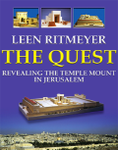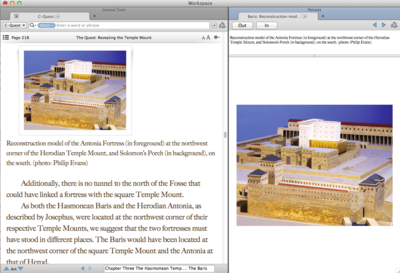 Last fall, we were pleased to announce the release of 13 books from Carta, an Israeli publisher which specializes in Bible maps, Atlases, and books on Biblical geography and archaeology. At the time, I talked about a few of those resources in detail, such as The Sacred Bridge, a genre-redefining Bible Atlas written with the help of Accordance, and Carta’s Illustrated Encyclopedia of the Holy Temple in Jerusalem. These resources, along with most of the books in the Carta collection, are fantastic reference works with detailed maps and illustrations you won’t find anywhere else. But there is one book in the Carta collection which is less a reference work to be consulted than a book intended to be read from cover to cover: Leen Ritmeyer’s The Quest. I’ve found this book so helpful in my research for a current writing project that I want to tell you about it now.
Last fall, we were pleased to announce the release of 13 books from Carta, an Israeli publisher which specializes in Bible maps, Atlases, and books on Biblical geography and archaeology. At the time, I talked about a few of those resources in detail, such as The Sacred Bridge, a genre-redefining Bible Atlas written with the help of Accordance, and Carta’s Illustrated Encyclopedia of the Holy Temple in Jerusalem. These resources, along with most of the books in the Carta collection, are fantastic reference works with detailed maps and illustrations you won’t find anywhere else. But there is one book in the Carta collection which is less a reference work to be consulted than a book intended to be read from cover to cover: Leen Ritmeyer’s The Quest. I’ve found this book so helpful in my research for a current writing project that I want to tell you about it now.
Look at most artistic reconstructions of the Temple Mount and you’re likely to see Leen Ritmeyer’s name attached to them. The architect of the Temple Mount Excavations following the Six-Day War, Ritmeyer has spent much of his life researching the mysteries of the Temple Mount and helping people visualize the ancient structures behind the present remains. The Quest is his personal chronicle of the research he has done, the challenges he has faced, and the answers he believes he has discovered.
Although Ritmeyer is a careful researcher who weighs countless minute details in the development of his theories, I’ve found The Quest to be a fascinating and enjoyable read. He tends to raise the questions and problems that need to be solved, chronicle how he has explored those questions, and then finally present his conclusions. There have been times in my haste that I’ve wanted to jump ahead to find the answers, but Ritmeyer’s writing is so engaging I find myself taking the time to read the entire discussion.
For example, Ritmeyer addresses some of the Biblical events associated with the summit of Mount Moriah, the “rock” now at the center of the golden-domed mosque known as the Dome of the Rock. How does this rock relate to the story of Abraham and Isaac in Genesis 22? What about the story of David building an altar at the threshing-floor of Araunah the Jebusite (2 Samuel 24)? While one can easily imagine Abraham binding Isaac on the relatively flat summit of Mount Moriah, Ritmeyer points out that the rock is too small to accommodate a threshing floor and that threshing floors are generally located just below the summit of a hill. Ritmeyer raises this problem at the beginning of chapter six, but doesn’t offer the solution until the end of chapter seven. In between he discusses every feature of the rock and its significance, followed by a brief biblical survey of the First Temple’s history. I must confess to skimming the detailed discussion of the rock itself, but I couldn’t stop reading Ritmeyer’s history of the first temple. He helped make sense of otherwise obscure references to events in the lives of Judah’s various kings, revealing that the temple itself went through various periods of neglect, ransacking, restoration, and expansion throughout the First Temple period.
Another point I’ve found fascinating is Ritmeyer’s contention that Hezekiah expanded the Temple Mount so that it measured 500-cubits square: dimensions mentioned in Ezekiel’s vision of a futuristic temple complex. Ezekiel’s vision would therefore have been reminiscent of the pre-exilic temple complex he would have been familiar with.
While The Quest is an important text for those studying biblical archaeology or the history of Israel, I would recommend it to anyone who wants to learn more about the temple and its place in Israel’s history. The project I’m working on is far from scholarly, but I want the statements I make about the temple to be based on credible research rather than baseless conjecture or questionable traditions. The Quest has given me the information I need from a credible source, with the surprising bonus that it has been an enjoyable and enlightening read. If you plan to preach through Samuel, Kings, Chronicles, the prophets, any of the post-exilic books, the Gospels, Acts, or many of the epistles (particularly Hebrews), I would highly recommend you include The Quest in your preparations.
Load it on your iPad and read it by the pool this summer. You’ll be surprised how much you enjoy it.


